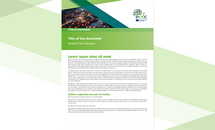Antimicrobial resistance in the EU/EEA (EARS-Net) - Annual Epidemiological Report for 2024
In 2025, all European Union/European Economic Area (EU/EEA) countries reported data for 2024 to the European Antimicrobial Resistance Surveillance Network (EARS-Net).
Antimicrobial resistance (AMR) can be expressed as the estimated total incidence of bloodstream infections with antimicrobial-resistant bacteria (infections per 100 000 population).
EU targets on antimicrobial resistance
- In 2024, the estimated total EU incidence of meticillin-resistant Staphylococcus aureus (MRSA) bloodstream infections was 4.48 per 100 000 population (EU country range 0.55−13.63). This was 20.4% lower than in 2019 (baseline year) and 0.31 per 100 000 population lower than the 2030 target of 4.79 per 100 000 population. For the EU overall, a statistically significant decreasing trend was detected between 2019 (baseline year) and 2024.
- The estimated total EU incidence of third-generation cephalosporin-resistant Escherichia coli bloodstream infections was 11.03 per 100 000 population (EU country range 3.75−22.79) in 2024. This was 5.9% higher than in 2019 (baseline year) and 1.65 per 100 000 population higher than the 2030 target of 9.38 per 100 000 population. For the EU overall, there was no statistically significant trend detected between 2019 (baseline year) and 2024.
- The estimated total EU incidence of carbapenem-resistant Klebsiella pneumoniae bloodstream infections was 3.51 per 100 000 population (EU country range 0.02−20.31) in 2024. This was 61.0% higher than in 2019 (baseline year) and 1.44 per 100 000 population higher than the 2030 target of 2.07 per 100 000 population. For the EU overall, a statistically significant increasing trend was detected between 2019 (baseline year) and 2024.
- In summary, while the EU target for the incidence of MRSA bloodstream infections had already been reached by 2024, the results for the other two EU targets were not on track. The estimated EU incidence of third-generation cephalosporin-resistant E. coli bloodstream infections with a 10% reduction target increased by more than 5% compared to 2019 (baseline year). Moreover, the estimated EU incidence of carbapenem-resistant K. pneumoniae bloodstream infections increased by over 60% compared to 2019, which differs substantially from the target of a 5% reduction by 2030.
Overall antimicrobial resistance situation in the EU/EEA
- Data from EARS-Net show that, as in previous years, AMR levels remained high in the EU/EEA in 2024.
- Increases in the estimated EU/EEA incidences of bloodstream infections with resistant bacteria were observed not only for two of the above-mentioned AMR-pathogen combinations with an EU target, but also for many other bacteria and antimicrobial groups under surveillance during the period 2020−2024, such as carbapenem-resistant E. coli, all resistance incidences for Streptococcus pneumoniae, and vancomycin-resistant Enterococcus faecium.
- The AMR situation reported by EU/EEA countries varied widely, depending on the bacterial species, antimicrobial group and geographical region. Higher AMR was generally reported by countries in southern, central and eastern Europe.
- For each bacterial species, country-specific information on the estimated incidence of antimicrobial-resistant bloodstream infections (including the recommended EU targets on AMR), the percentage of invasive isolates with AMR, data availability and the percentage of intensive-care-unit patients is available in the country summaries. Results by age group and sex are available in the ECDC Surveillance Atlas of Infectious Diseases (https://atlas.ecdc.europa.eu/).
Public health conclusions
- Estimates based on EARS-Net data from 2020 indicate that each year more than 35 000 people die in the EU/EEA as a direct consequence of antimicrobial-resistant infections.
- The poor progress towards the EU targets on AMR overall and the many increases in the estimated EU/EEA incidences of bloodstream infections with resistant bacteria in the EU/EEA highlight the urgent need for intensified public health action against AMR.
- The Council Recommendation on stepping up EU actions to combat AMR in a One Health approach (2023/C 220/01) encourages Member States to develop and implement national action plans against AMR, and highlights the need for Member States to allocate appropriate human and financial resources for the effective implementation of these plans.
- In the absence of stronger, swifter public health action, it is unlikely that the EU will reach all its AMR targets by 2030. Moreover, AMR will continue to jeopardise EU preparedness, leading to an increased number of infections with antimicrobial-resistant bacteria that will be more difficult to treat, greater challenges for patient safety and a rise in AMR-related deaths.
Download








